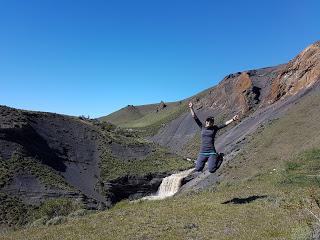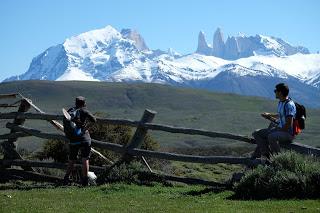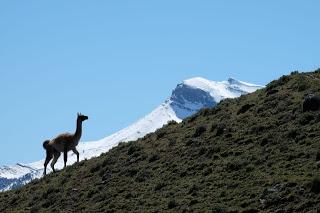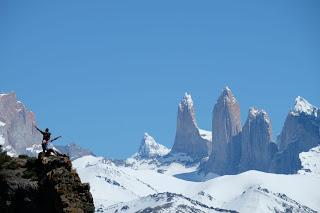
El Salto de Las Chinas es una pequeña catarata del río Las Chinas (recibe este nombre por las Chinas que acompañaban a la exploradora Florence Dixie en sus viajes por La Patagonia) que es algo así como un mito en el campamento AWASI.


¿Y por qué es un mito? Pues porque es la excursión de cabecera para los trabajadores de AWASI pero si indagas un poco descubres que, aunque todo el mundo ha hecho la excursión, nadie ha estado ahí realmente porque no lo encontraron.


Todo el mundo te da las mismas indicaciones: vas al puesto del leonero, sigues el camino de los caballos hacia la Estancia de Santa Gemita (abandonada hace años) y desde ahí vas a la derecha sobre el cerro y ya casi estás en el salto. Esto te lo repite cualquiera al que preguntes como si fuese un mantra.

Al final resulta que sólo han estado ahí un par de los guías y porque han ido con el gaucho Pablo que les guía las cabalgatas de los huéspedes.


Obviamente la primera vez que fuimos no encontramos el salto, así que caminamos algo más de 20 km sin ver ni siquiera una triste caidita de agua de unos centímetros.

Decidimos volver a intentarlo por tozudería y convencimos a Pepe para que nos acompañase. Teníamos dos ventajas esta vez: había estado lloviendo los últimos tres días por lo que el río iba a ir crecido y unos huéspedes iban a hacer la misma excursión que nosotros pero a caballo, por lo que con lo embarrado que estaba el camino, podríamos seguir las pisadas de los caballos.

Salimos pronto por la mañana. Hacía un día legendario: después de las inundaciones de los últimos días había amanecido sin una sola nube y, cosa rara, sin nada de viento.

Caminamos hasta Santa Gemita donde nos encontramos a los jinetes que ya volvían. Así pudimos encontrar el camino de los caballos y seguirlo bordeando la sierra.

Perdimos el rastro de los caballos sin darnos cuenta por lo que ascendimos mucho más de lo necesario; esto lo supimos más tarde. Vimos cóndores y guanacos mientras caminábamos al borde de la desesperación por no encontrar El Salto.


Llegamos a un punto en el que el Río Las Chinas se dividía en dos y todo parecía llano aguas arriba. Así que nos rendimos. Deicidimos comer en la cima de unas formaciones rocosas espectaculares que servían de mirador a un meandro espectacular del Río Las Chinas.

En ese momento lo ignorábamos, pero estábamos comiendo justo encima del Salto de Las Chinas. Después de comer en ese mirador increíble, con las Torres del Paine casi al alcance de la mano, decidimos volver hacia Santa Gemita más cerca del río.


Bajamos de las montañas y, sorpresa, volvimos a encontrar el rastro de los caballos. Se nos pusieron los ojos como platos (ojipláticos) y prácticamente corrimos siguiendo la caminito ecuestre.

Nos llevamos una tremenda sorpresa al descubrir que, justo en medio del gran meandro sobre el que habíamos comido los bocadillos, estaba el famoso Salto de Las Chinas. En el fondo es una pequeña catarata de agua marrón pero encontrarlo era ya cuestión de orgullo.Una vez en el Salto conectamos el GPS del teléfono que va con la app que utilizamos para hacer las excursiones en las Rocosas (ViewRanger) y grabamos el camino de vuelta. Caminamos un total de ocho horas en las que hicimos algo más de 25 km.KENOS, EL HÉROE DE LOS ONAS (mito Selk’nam)
Kenos, nacido de la cúpula celeste bajó a la Tierra deslizándose por una cuerda. Justo en el momento en que Kenos se posó en el suelo la cuerda se rompió, motivo por el cual Kenos no volvió de inmediato a la cúpula celeste ya que lo que vio en la Tierra no le gustó nada. La Tierra era chata e informe y estaba rodeada por Kox, el mar. Kenos creó las montañas y barrancos y los distribuyó por el mundo. La luz era escasa y uniforme, todas las horas pasaban en medio de un alba enfermiza, por lo que Kenos creó al Sol y la Luna, ordenando al Sol (Krren) que brillara más fuerte a mediodía y que se retirase por la tarde para dar paso a la Luna (Krah) y su luz banca. Los árboles eran bajos y achaparrados porque el cielo los aplastaba, por lo que Kenos lo empujó hacia arriba, permitiendo a los árboles crecer altos y hermosos.
Enrique & MarinaEnglish versionTHE WATERFALL OF LAS CHINAS

The river of Las Chinas has a mythic drop near our camp in Awasi. The name of the river literally means “the Chinese women” and it was named after the the Chinese ladies who did all the portering duties for Florence Dixie when exploring Patagonia.


You might be wondering what’s so mythic about a waterfall. The hike that takes you there is meant to be easy to access and you can start walking from your doorstep which makes it a really great pastime for the staff’s days off. But if you start asking for directions and information everything turns confusing, no one can really tell you the way and depending on who you talk to you’ll get different instructions. Furthermore, they all say they got lost at some point and many would admit that they didn’t really find the actual waterfall.


The first few steps are clear and everyone repeats them as a mantra: follow the driveway up to the turn towards the lion keeper’s hut. Then follow the 4WD road towards the abandoned estancia of Santa Gemita. Leave the estancia on your left and walk up and over the hill and you’re pretty much there. Everyone can tell you up to this point, even the ones who got here yesterday.

It’s when you ask for further directions that you find out that there’re only a couple of guides who have actually been there with Pablo the Gaucho taking guests on a horseback ride.


Obviously, the first time we tried to go we couldn’t find the spot. Enrique and one of our colleagues walked over 20 pointless kms not to see a single sing of the waterfall.

He had to give it another go with me and we also took Pepe with us who had been there before. This time we had a few more factors in our favour: it had been raining heavily over the last few days and the river was going to be really full; we knew that there were some guests going and therefore we could follow the horses’ footprints on the wet ground; we had lots of time, tons of food and the three of us agreed on not coming back to the camp until we had found the waterfall.

We left in the morning after breakfast and the day was legendary: after several days of rain and serious floods the day turned out to be bright, sunny, still and the sky was completely clear of clouds.

We walked up to the abandoned estancia of Santa Gemita where we met the riders already coming back. We followed the horses’ marks up the hill and around the range.

Eventually we lost their trace and started following a guanacos’ trail which ascended way more that it was necessary. We saw lots of Andean condors and hundreds of guanacos while at the same time we were getting more and more desperate to find the mythic waterfall.


We got to a very high viewing point where we could see that the river Las Chinas splits in two and that both upstream branches looked completely flat. That was it. We gave up and had lunch right there where the rock formations were so unique and the views over the river meander were so spectacular.

At that point we had no idea that what we were actually overlooking was the aforementioned waterfall. After eating some lunch with the Torres pretty much at the reach of our hand, we decided to turn back to Santa Gemita taking a lower line this time.


Descending the hill we found the horse tracks again. We couldn’t be happier. Of course we started following them once more.

After only two minutes following the tracks we got to a lookout where we discovered that the famous waterfall was located just in the middle of that massive meander we could see from our lunch spot. To be very honest, the waterfall is a little jump compared with others we’ve seen before and after the rain it was brown and ugly. Regardless the level of spectacularity of the scene, finding it was a matter of pride and pigheadedness. Enrique turned the GPS of his phone on and recorded the way back with an app that we’ve been using to find trails in Canada called ViewRanger. The whole trail and stops took us just over eight hours and we walked about 25 kms. KENOS, THE ONA’S HERO (Selk’nam myth)
Kenos was born in the sky and descended to Earth using a rope. As soon as Kenos reached the ground the rope broke. Kenos didn’t like what he saw on Earth but he was stuck down there. The Earth was flat, boring, had no shapes and was surrounded by Kox, the sea. Kenos made mountains and cliffs and spread them over the land. The light was minimum and always the same. Kenos forged the Sun and the Moon. Then he commanded the Sun (Krren) to be brighter at midday and leave the Moon (Krah) shine with her white light at night. The threes used to be short and stunted because the sky pushed them down until Kenos lifted them up and allowed them to grow high and leafy. Enrique & Marina
